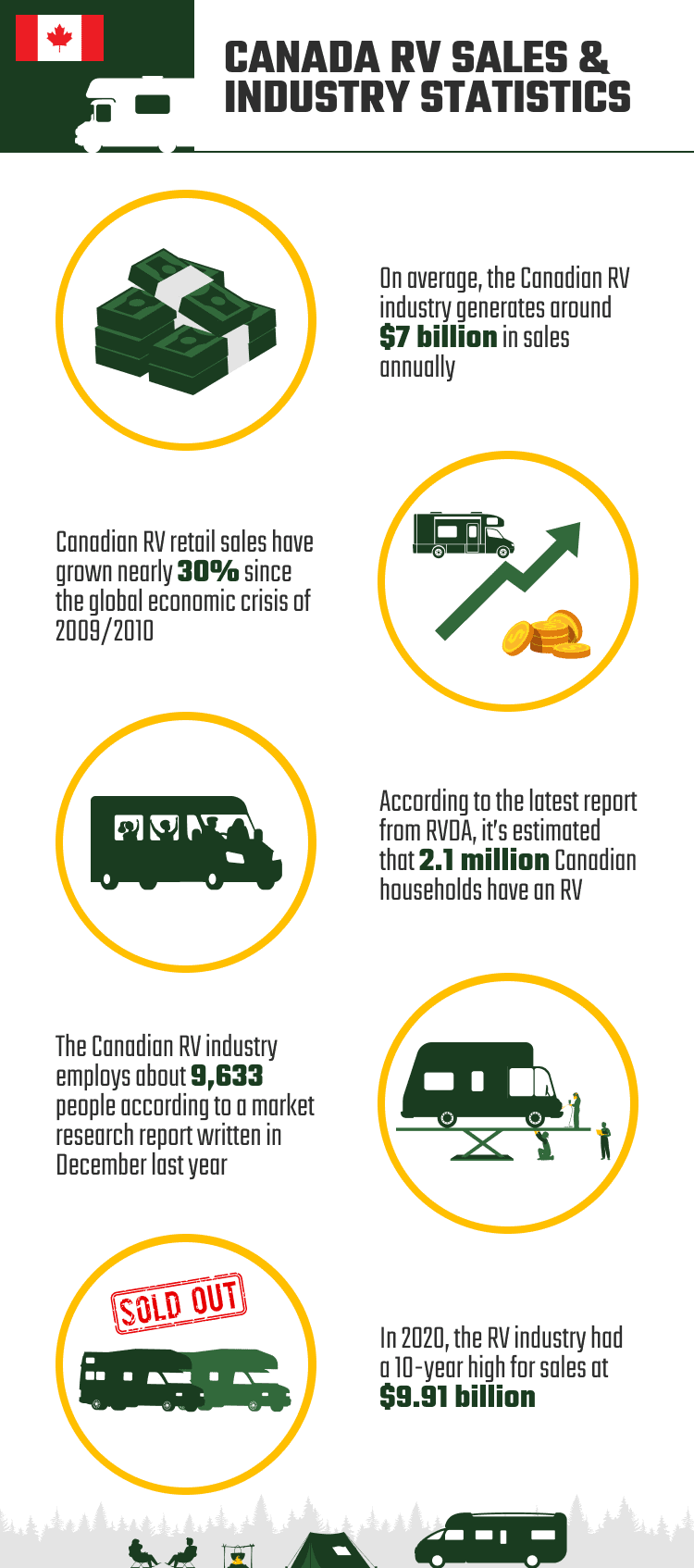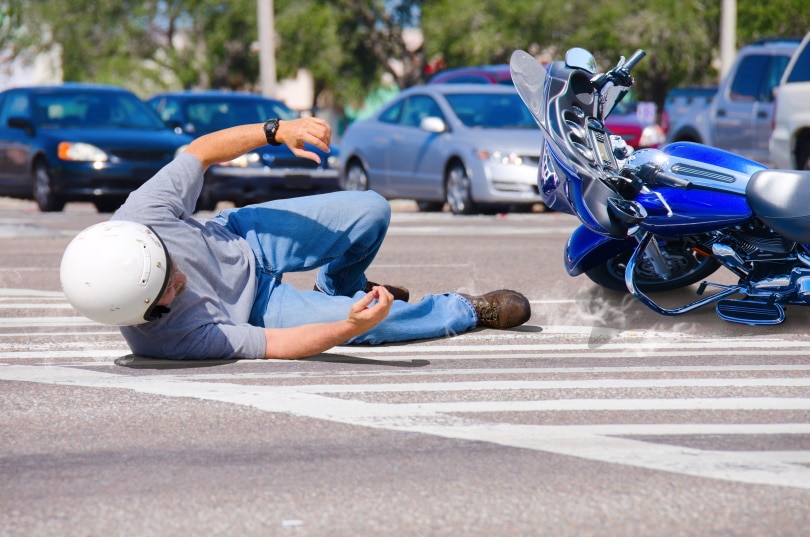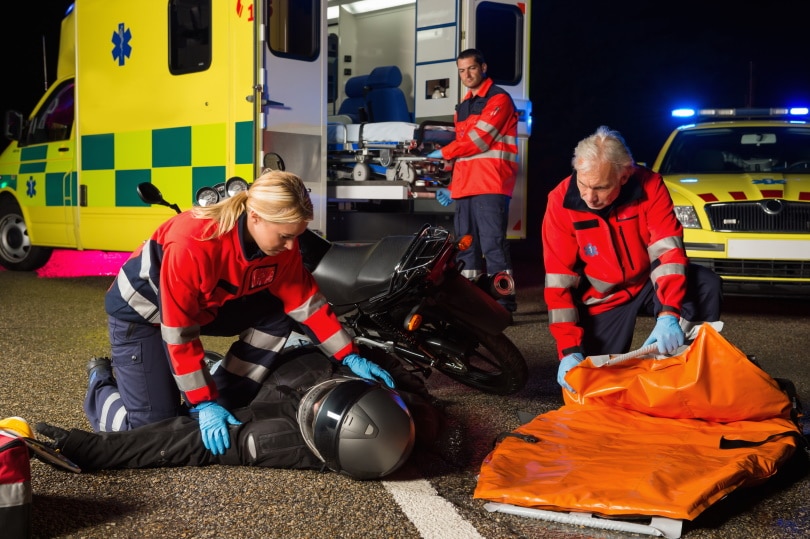10 Motorcycle Accident Statistics in Canada: 2025 Update
-
Shea Cummings
- Last updated:

Note: This article’s statistics come from third-party sources and do not represent the opinions of this website.
There is nothing quite like cruising down the road on a motorcycle with the wind in your face. Although it is not for everyone, many people find it exciting. Unfortunately, it’s not without increased risk compared to driving in a car.
This article looks at 10 statistics about motorcycle accidents that may shock or surprise you. Most of them are recent, within the last couple of years. However, some are a bit older, but still the most current info we have.
Click to Skip Ahead:
Top 10 Motorcycle Accident Statistics
- From 2008 to 2014 in Ontario, 24.5% of all motorcycle accident deaths were due to alcohol.
- 3% of motorcycle accident deaths in Ontario from 2008 to 2014 were caused by riders not paying attention.
- Between 2012 and 2021, 36.8% of motorcycle accidents involved a single motorcycle.
- The odds of dying in a motorcycle crash are 1 in 799, as of a 2020 report.
- Motorcycle accidents are 30 times more likely to result in fatalities than automotive accidents.
- In 2020, there were 42 deaths from motorcycle accidents in Ontario alone.
- Between 2009 and 2018, 91% of motorcycle accident fatalities were men.
- 5% of all motorcycle accident deaths occurred on Saturdays between 2009 and 2018.
- In accidents involving an automobile, 69% of them showed no signs of avoidance.
- Wearing a helmet is 37% effective at preventing death during a motorcycle accident.

Causes of Accidents
1. From 2008 to 2014 in Ontario, 24.5% of all motorcycle accident deaths were due to alcohol.
(OntarioPolice)
Between 2008 and 2014, there were 175 deaths in Ontario. 24.5% of the fatalities, which represented 43 people, were caused by intoxication. That is a pretty significant number of deaths that could have been avoided by not drinking and driving.
Another thing to consider is that this was only Ontario; other large provinces, such as Quebec and British Columbia, probably have similar losses from intoxicated riders.
2. 10.3% of motorcycle accident deaths in Ontario from 2008 to 2014 were caused by riders not paying attention.
(OntarioPolice)

In the same report as above, 10.3% or 18 of those 175 deaths resulted from rider inattention. This could be distracted driving, like trying to read a text message while riding. But it would also include being distracted by an animal or something on the side of the road.
This may not be a ton of deaths in 6 years, but it shows the importance of paying attention while riding.
3. Between 2012 and 2021, 36.8% of motorcycle accidents involved a single motorcycle.
(CTV)
In a study on 326 motorcycle accidents that resulted in 342 rider deaths, the Ontario Provincial Police (OPP) discovered something startling. Out of those 326 collisions, 120 of them only involved the motorcycle and no other vehicle.
The above stats regarding deaths due to alcohol or not paying attention really puts this into perspective. Being sober, paying attention, and driving to the conditions are all so important for everyone’s safety.
 Chance of Injury or Death
Chance of Injury or Death
4. The odds of dying in a motorcycle crash are 1 in 799, as of a 2020 report.
(InjuryFacts)

Odds of 1 in 799 don’t seem terrible, and while the danger shouldn’t scare a person from trying to ride a motorcycle if it’s something they want to do. However, many factors could affect these odds.
For example, suppose a person is driving erratically while intoxicated. In that case, the chances of getting in a bad accident begin increasing, which leads to a higher chance of death. So, don’t be scared of riding, but respect it and ride accordingly.
5. Motorcycle accidents are 30 times more likely to result in fatalities than automotive accidents.
(Injured)
Reading a statistic with odds like 1 in 799 might seem great. But there is a massive difference when you compare the chance of death in a motorcycle accident versus an automobile accident. A motorcycle accident is 30 times more likely to result in the rider or riders dying than an accident involving two cars.
Some ways a motorcyclist can lower these chances include wearing a helmet, wearing protective gear, driving to conditions, and paying attention to their surroundings.
6. In 2020, there were 42 deaths from motorcycle accidents in Ontario alone.
(CBC)

OPP released a report last year that warned motorcyclists to ride with caution. In 2020, 42 people were killed in Ontario, and this was the most deaths from motorcycle accidents that the province had seen in a decade. What’s more shocking is that 37 accidents did not involve any other vehicle. So, in theory, all of them should have been preventable by the person operating the motorcycle.
7. Between 2009 and 2018, 91% of motorcycle accident fatalities were men.
(GovBC)
British Columbia is another province that has a fairly significant accident and death rate. One interesting thing that is noted in a report put out by the BC government is that over a decade, 91% of the accident fatalities were men. And 25.6% of the fatalities were men aged 50–59, followed by the 40–49 age group at 19.7%.
8. 23.5% of all motorcycle accident deaths occurred on Saturdays between 2009 and 2018.
(GovBC)

One wouldn’t think that the day of the week would significantly affect the number of accident deaths. However, according to the statistics released in the same report as above, 23.5% of motorcycle accidents occurred on Saturdays.
Coming in behind Saturday was Sunday, with 17.6% of the deaths. This suggests that many deaths were people out for a weekend cruise. Perhaps less experienced if they only rode on the occasional weekend.
 Accident Prevention
Accident Prevention
9. In accidents involving an automobile, 69% of them showed no signs of avoidance.
(HGLegal)
There was a study done in Europe that’s still applicable to learn from in Canada. The study discovered that in motorcycle accidents that involved another vehicle, 69% of them showed no collision avoidance on the part of the automobile.
This suggests that the vehicle’s driver didn’t even see the motorcycle in most accidents. This is why it’s essential as a driver to pay attention to the surroundings during motorcycle season. It’s easy for a bike to fit in a car or truck’s blind spots.
10. Wearing a helmet is 37% effective at preventing death during a motorcycle accident.
(CDC)

When we see that a helmet increases the chances of survival by 37% for the driver and 41% for their passenger, it should solidify the importance of wearing one. In addition to drastically increasing the odds of survival in a crash, helmets also show a 69% reduction in the risk of a head injury.
 Frequently Asked Questions About Motorcycle Accidents in Canada
Frequently Asked Questions About Motorcycle Accidents in Canada
What is the most common motorcycle accident injury?
In the case of nonfatal motorcycle accidents, the lower body parts, such as the legs, knees, or feet, typically sustain injuries. However, upper body injuries are often the most common in fatal accidents. Injuries to the spine or head can quickly lead to death if severe enough.
What causes motorcycle accidents?
Many things can go wrong and cause a motorcycle accident. As we saw in the statistics above, alcohol and lack of attention cause a lot of crashes. However, many other things, such as driving too fast, lacking experience, or even a mechanical malfunction, can all lead to an accident.

Do you have to wear a helmet while riding a motorcycle in Canada?
Each province and territory governs its motorcycle safely independently, much like each state in the United States. However, unlike some states, each province requires anyone on a motorcycle to wear a helmet.
What should I do after a motorcycle accident?
In the event that you’re in a motorcycle accident, there are a couple of things to do. It should go without saying to get the proper medical help that you need. But if you’re able, you should get the other driver’s insurance information (if someone else is involved). Don’t touch the bike or disturb the accident scene before the police arrive. Also, take pictures if you can. In most situations, contacting a lawyer to represent you is a huge benefit.
 Conclusion
Conclusion
Thousands of people around the country love to spend the summer on their motorbikes. These statistics should not scare people away from going for a cruise. However, they should stress the importance of driving safely to the conditions and ensuring you’re sober and paying attention.
Even if you’re wearing all the best protective gear, there’s still a huge risk of the accident turning out worse than it would be in an automobile.
See also:
- 11 Car Fire Statistics in Canada
- 7 Moped Accident Statistics in Canada
- 10 Car Accident Statistics and Facts in Canada
Featured Image Credit: DedMityay, Shutterstock
Contents

 Chance of Injury or Death
Chance of Injury or Death